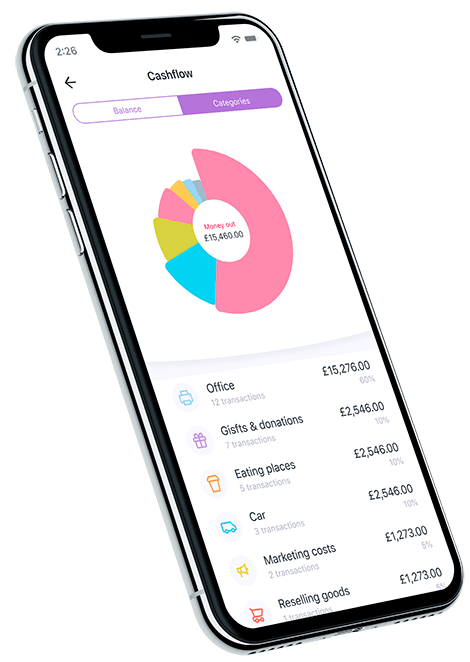Everything you need to know about small business invoices

Invoices are the lifeblood of a small business. They make sure you get paid on time and help support healthy cash flow. But for most business owners, they are not a priority. Secure the work, do the job, land the dough. That's usually the focus. However, understanding the invoicing process, when to bill and the full range of options available to sole traders is essential. So what is an invoice, why are they so important, and what are the best ways to manage, record and process them?
What is an invoice?
Put simply, a sales invoice is an agreement in writing. A document that confirms money will be paid from one party to another for goods or services provided. They are not always 'static' documents, however. They have a life cycle. Depending on the current status of any work in hand, you may be looking at a raised invoice, a pending invoice or a paid invoice, for example.

As well as different stages in the life of an invoice, there are also different types. Understanding the right kind to put in front of a client is vital.
|
A quotation contains the full amount a customer should pay on completion of a project. It's a friendly way to scope out the work and sets expectations for both parties. |
An interim invoice breaks down payments into manageable chunks. If you're in the building trade, for instance, it's common practice to ask for payments week to week as you tick off completed sections of construction work. |
A final invoice is sent out at the end of a project to let the customer know everything is done. At which point you are either paid in full or receive the final part of a staggered payment arrangement. |
A reminder lets your customers know they are overdue with their payment and they really ought to settle the bill. |
A quotation contains the full amount a customer should pay on completion of a project. It's a friendly way to scope out the work and sets expectations for both parties.
An interim invoice breaks down payments into manageable chunks. If you're in the building trade, for instance, it's common practice to ask for payments week to week as you tick off completed sections of construction work.
A final invoice is sent out at the end of a project to let the customer know everything is done. At which point you are either paid in full or receive the final part of a staggered payment arrangement.
A reminder lets your customers know they are overdue with their payment and they really ought to settle the bill.
What information should I include on an invoice?
You may not know exactly what to show on a business invoice. There are certain things everyone must include to make a viable and professional-looking document. And we've written them down for you. So whether you use a scrap of notepaper, a professional template, digital app or cigarette pack, it pays to remember these essentials when quoting or billing a client.

Having a template with some of the details prefilled really helps. Also, make sure it's neat and on-brand to make it look more professional.
What is an invoice address?
The invoice address is the home or business where the seller sends the sales invoice or receipt - the one that appears on a customer's credit card or bank account. It's also the shipping address where goods are delivered.
How to create invoices - and track them
First and foremost, assign each newly created document a unique invoice number to distinguish it from all others. Numbers only need to mean something to you, so choose any system you like. Just make sure they are sequential. Include the initials of your company with the invoice number so you can recognise your own transactions at a glance.
Next, keep a tally of paid, unpaid and overdue invoices - this helps you to quickly assess how many payments to expect and who you need to send a kind reminder to.
How to understand subtotals, totals and tax
Before you apply any additional costs for VAT (only do this if you're VAT registered), you should show a subtotal near the bottom of your invoice. This is the amount you arrive at after adding together all the units you've sold or hours you've worked. At this point, you apply your VAT rate to produce a total. Put this at the end of the invoice just below the subtotal. The total amount is what your customer should pay you.
How to set payment terms
Don't be afraid to set tight deadlines; it's good practice. Some clients are chronic late payers (you can't help that), but the majority will respect your terms and pay on that basis.
Give short time frames so if you need to chase payments you can start sooner. According to the Federation of Small Business, around 50,000 small to medium-sized companies go bankrupt each year, in part due to late payments. Reassuringly, the government is introducing new regs to combat this. But one of the best ways to beat the late payers and stay afloat is to automate your processes through digital, trackable invoicing linked to a bank account.
Repeat your terms on every subsequent version (it's common to use 14 days or 30 days) no matter how many invoices you send a customer. This reinforces the agreement but also leaves you some scope to offer a discount for early payment. Use discounts infrequently though. They are gentle sales incentives. You don't want to be haggling over price every other week. And if you list any late payment penalties, try to avoid actually enforcing them. They are hard to carry out legally (and are often capped legally). Try to negotiate and resolve issues in good faith. You're more likely to retain a client in the long term.
How to send an invoice
The quickest way is to email a PDF to your customer. Some of your customers may prefer a printed version, however, so make sure to keep a digital copy too just in case.
How to ensure an invoice is paid on time
- Go digital. Poor admin is often a major reason for late payments. With Amaiz, you can quickly raise a branded invoice from our app. We've automated your routine, so calculations are done for you, cutting down on mistakes and hours of admin
- Raise customer invoices as soon as you've completed work or delivered on a project. With Amaiz banking, you can email invoices directly to your customer from your phone. You don't need to wait until you're back at the home PC
- Agree to favourable payment terms with your customers. For example, if your suppliers are expecting you to make payments within 30 days, provide 15 days' terms to your customer, just in case of late payment. It is also important to discuss payment terms when you start doing work for a client to avoid any unpleasant surprises and set appropriate expectations.
Over here at gov.uk you can find more details on invoicing and payment terms.
Amaiz small business banking features invoicing in our app, with customisable templates, room for your logo or branding, and the ability to track jobs by status. The more smoothly you manage your admin, the less likely it is that you'll make common invoice mistakes. Especially when you have demanding clients or an uptick in activity.
If you have questions about invoicing or accounting, our expert team is always happy to help. You can reach out to them any time on email or in the app.

Download now!
And you can open a business account with all the support you need in minutes.




